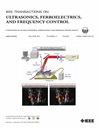激光碎石中的三维超分辨率被动空化绘图。
IF 3
2区 工程技术
Q1 ACOUSTICS
IEEE transactions on ultrasonics, ferroelectrics, and frequency control
Pub Date : 2024-08-16
DOI:10.1109/TUFFC.2024.3443781
引用次数: 0
摘要
肾结石病是一个重大的公共卫生问题。激光碎石(LL)通过反复的激光照射击碎结石,已成为治疗肾结石病的主要方法。激光诱导的空化与 LL 中的结石损伤密切相关。因此,监测激光碎石过程中的空化活动对于优化结石损伤和最大化激光碎石效率至关重要。在这项研究中,我们开发了三维超分辨率被动空化绘图(3D-SRPCM),其中空化气泡位置的定位精度可达 40 μm,是声衍射极限的 1/10。此外,通过采用基于 GPU 的稀疏矩阵波束成形方法,3D-SRPCM 重建速度提高了 300 倍。利用三维-SRPCM,我们研究了在水的自由空间和肾脏模型的封闭空间中,LL 在 BegoStones 上诱发的空化活动。3D-SRPCM 提供的剂量依赖性分析表明,结石表面累积的冲击压力与结石损伤的相关性最高。通过在 LL 治疗过程中提供高分辨率空化图,我们预计 3D-SRPCM 将成为提高临床 LL 效率和患者预后的有力工具。本文章由计算机程序翻译,如有差异,请以英文原文为准。
Three-Dimensional Super-Resolution Passive Cavitation Mapping in Laser Lithotripsy
Kidney stone disease is a major public health issue. By breaking stones with repeated laser irradiation, laser lithotripsy (LL) has become the main treatment for kidney stone disease. Laser-induced cavitation is closely associated with stone damage in LL. Monitoring the cavitation activities during LL is thus crucial to optimizing the stone damage and maximizing LL efficiency. In this study, we have developed 3-D super-resolution passive cavitation mapping (3D-SRPCM), in which the cavitation bubble positions can be localized with an accuracy of
$40~\mu $
m, which is 1/10th of the acoustic diffraction limit. Moreover, the 3D-SRPCM reconstruction speed has been improved by 300 times by adopting a GPU-based sparse-matrix beamforming approach. Using 3D-SRPCM, we studied LL-induced cavitation activities on BegoStones, both in free space of water and confined space of a kidney phantom. The dose-dependent analysis provided by 3D-SRPCM revealed that accumulated impact pressure on the stone surface has the highest correlation with the stone damage. By providing high-resolution cavitation mapping during LL treatment, we expect that 3D-SRPCM may become a powerful tool to improve the clinical LL efficiency and patient outcome.
求助全文
通过发布文献求助,成功后即可免费获取论文全文。
去求助
来源期刊
CiteScore
7.70
自引率
16.70%
发文量
583
审稿时长
4.5 months
期刊介绍:
IEEE Transactions on Ultrasonics, Ferroelectrics and Frequency Control includes the theory, technology, materials, and applications relating to: (1) the generation, transmission, and detection of ultrasonic waves and related phenomena; (2) medical ultrasound, including hyperthermia, bioeffects, tissue characterization and imaging; (3) ferroelectric, piezoelectric, and piezomagnetic materials, including crystals, polycrystalline solids, films, polymers, and composites; (4) frequency control, timing and time distribution, including crystal oscillators and other means of classical frequency control, and atomic, molecular and laser frequency control standards. Areas of interest range from fundamental studies to the design and/or applications of devices and systems.

 求助内容:
求助内容: 应助结果提醒方式:
应助结果提醒方式:


